Recently, Oakland city staff proposed revisions to the controversial Percent for Art ordinance , which will be discussed at a March 14th Community & Economic Development subcommittee meeting, a preliminary step before a full City Council hearing.
Most of the changes are minor, intended to clarify fuzzy language in the ordinance. But one proposed revision is not so innocuous: city staff has recommended incentivizing the “in-lieu” contribution to make that option more attractive to developers.
The implications of this could be vast, especially since staff has also recommended imposing a moratorium on further revisions to the ordinance for at least 12 months, and likely longer. The moratorium effectively tables community calls for additional options for allocations of this fee, and potentially negates provisions negotiated in recent Community Benefit Agreements (CBAs) which would direct developer contributions to a city-owned cultural institution.
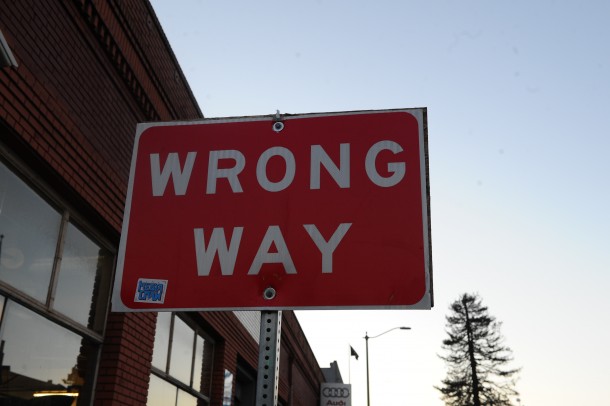
Is the city making a mistake by refusing to consider alternatives to its public art ordinance at this time?
That’s a lot to unpack. Let’s start with the ordinance itself, which was first proposed in fall 2014 and adopted in early 2015. Originally sponsored by then-Councilmember Libby Schaaf, the ordinance added a provision for private development to the city’s existing Percent For Art program.
Minutes from Public Art Advisory Committee (PAAC) meetings show that the recommendation to incentivize the in-lieu contribution was first recommended in September 2014. Although the rationale stated at the time was that “funds … can be administered wisely and with broad perspective,” any funds generated through the in-lieu contribution are, in fact, administered by the PAAC itself, meaning that it basically recommended that it be given more control over public art projects, without also increasing public accountability.
The PAAC also had many other concerns about the ordinance back in 2014. Specifically, it requested “more clarity on how the policy would be implemented, in particular as it relates to staff oversight; the workload impact; how artists would be selected; and how contracts and artwork would be reviewed,” Those concerns went unaddressed at the time.
Other concerns were raised by an ad hoc community group called ArtivistPAC (which later morphed into the Oakland Creative Neighborhoods Coalition). ArtivistPAC took issue with the lack of inclusive community outreach during the drafting process, as well as the ordinance’s limited scope – it was reportedly based on a single case study, that of Emeryville, despite the existence of more than 400 similar programs around the country. ArtivistPAC also recoiled at the developer-friendly provisions of the legislation, noting that the ordinance essentially made them art curators, with no public oversight or community input into any onsite project.
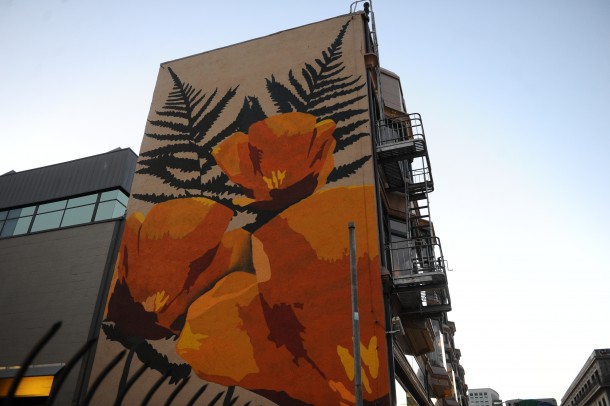
A PAAC-approved mural painted by CRP on 15th St.
Despite these concerns, in November 2014, Schaaf convinced ArtivistPAC members not to speak out against the legislation’s shortcomings. She claimed that unspecified pro-development members of City Council would seek to squash the ordinance if it wasn’t passed immediately, and promised that the ordinance could easily be amended once ratified. Yet at a follow-up meeting in January 2015 attended by developers, city staff, and members of the arts community, only minor adjustments were made to the ordinance.
The next flashpoint came in July 2015, when the the Bay Area branch of the Builders Association of America—a consortium of millionaire developers—joined with conservative non-profit the Pacific Legal Foundation to file a lawsuit which claimed, among other things, that the ordinance was “violating constitutional protections for property rights and free speech.”
Since then, there has been almost no news about the lawsuit, which was filed in federal civil rights court—making a favorable ruling potentially impactful on every similar program throughout the country. The City Attorney’s office, as per policy, does not comment on pending litigation.
As for the ordinance? It, too, seemed to fly under the radar. Public records show that only one proposed project involving the Percent for Art program has come up for PAAC review – in February of 2017.
However, the ordinance did come into play in recent CBAs negotiated by the Community Benefits Coalition (of which the Community Rejuvenation Project is a member). At the behest of Councilmember Lynnette McElhaney, Bay Development agreed to direct its public art contribution to the Malonga Casquelourd Center for the Arts (MCCA) — even though the ordinance legally allowed no such provision. McElhaney insisted that revising the ordinance to allow for an offsite allocation to a cultural institution would not be difficult; that precedent then informed a subsequent CBA negotiated with Wood Partners, which directed an even more sizable contribution to MCCA.
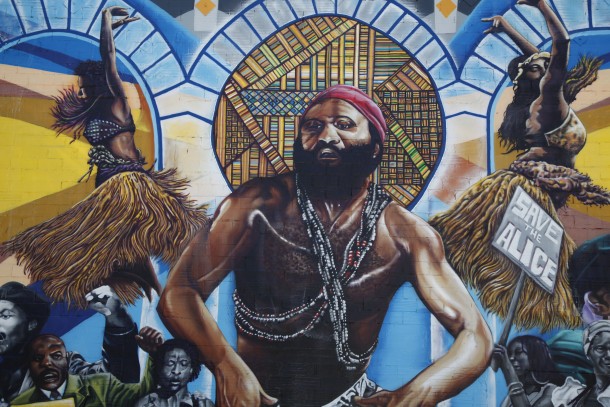
CRP portrait of Malonga Casquelourd. The arts center named in his honor stands to lose hundreds of thousands in CBA agreements unless the city’s public art ordinance is revised to allow for offsite contributions.
From the standpoint of the Community Benefits Coalition, offsite contributions to public art projects or cultural institutions within close proximity of proposed developments are a way to directly offset the detrimental aspects of development, and could be potentially be used for a wide variety of options, including stabilizing cultural anchors such as MCCA or Oakland Asian Cultural Center; supporting anti-displacement/population retention efforts by commissioning art which honors cultural diversity and/or neighborhood history; and mitigating blight in urban environments through “anti-graffiti” murals.

Murals, such as this one by Luqman of Dragon School, have been effective at reducing blight and tagging in neighborhoods undergoing development.
That argument is in direct opposition to the city’s rationale for incentivizing the in-lieu contribution, which it claims will result in more widespread distribution of public art funds across the city.
The staff report (of which CRP obtained a copy before it was removed from the city’s website; it had not been reposted at the time of this writing, but when it is, will be listed here) identifies “equity issues” with directing funds to neighborhoods in which development is taking place – ignoring the fact that District 2 and District 3 both suffer from excessive tagging, and that single-room occupancy hotels as well as low-income senior populations are in close proximity to at least three proposed Downtown developments.
According to the city, a “public process” already exists through the PAAC, however, that is not the same as communities directly impacted by gentrification and displacement having some say in mitigating those impacts through the commissioning of public art.
The report goes on to note that addressing community concerns at this time would present “significant implementation challenges,” and recommends that any broader changes be integrated into the city’s upcoming Cultural Plan and Downtown Oakland Specific Plan (which won’t be completed until 2019). The report also states that no further revisions will be considered prior to the end of 2017; no specific timeline is outlined for “community and stakeholder discussions” of these issues.
Which means that if the revised ordinance is passed as proposed, the CBA funds for MCCA will have likely been rendered void, a turn of events which doesn’t advance the equity argument, since by all accounts, MCCA—which mainly serves communities of color—is underfunded and badly in need of renovation and improvements to its affordable housing units.
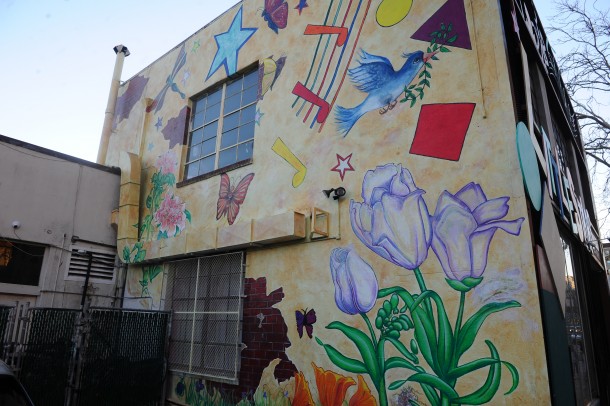
A PAAC-approved mural on 14th St.
Furthermore, de-incentivizing onsite contributions may directly contradict one of the Public Art Program’s primary objectives, “promoting and facilitating collaborations between artists, architects, landscape architects, engineers and other designers in all public construction or urban design projects and by encouraging such collaborations in the private sector.”
Conversely, incentivizing the in-lieu contribution gives the PAAC more autonomy, but not more accountability to community. For one thing, the PAAC’s track record is uneven – it has greenlit community-oriented projects by CRP, Attitudinal Healing Connection, East Side Arts Alliance, and others, but it also approved a $600,000 installation – which some have called a monument to Uptown gentrification – known as the 17th. St. BART gateway.
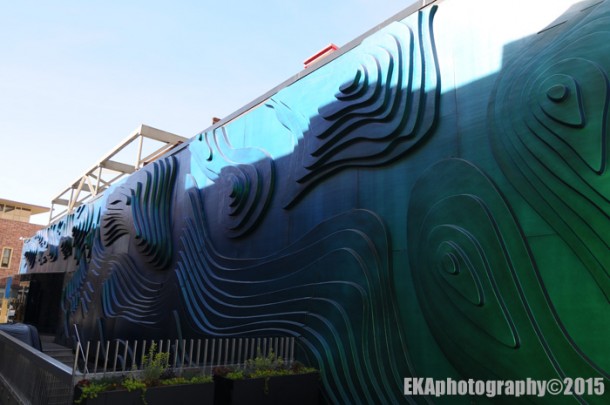
The 17th St. BART gateway reportedly cost $600,000.
The March 14th CED meeting offers opportunities for the public to voice any concerns over the public art ordinance. But it’s disconcerting that the staff report indicates the city’s desire to mute those concerns, by refusing to consider alternative options.
At this point, it’s unclear whether the staff report will be further amended before the committee hearing. While there is much reason to be skeptical of the city’s intention, to be fair, the stakeholder meetings suggested in the staff report could conceivably result in a more equitable process, somewhere down the line. Yet making that a reality may require a review of all past public art projects by the Department of Race and Equity, as well as a revision of PAAC by-laws and the Public Art Program objectives — neither of which contain any specific language around equity or prioritizing historically-underserved communities.
The one silver lining in this convoluted and seemingly-contradictory process is that the city has tipped its hand as to where it wants to go with the public art ordinance revisions. The delayed public hearing allows more time for impacted community groups and creative artists to mobilize and strategize around their concerns, and address the flaws in both of the available options presented — and possibly make a stronger case for alternative options.
That may turn out to be a good thing, because it would be completely ironic for the city to use an equity argument to frame a process which would negate signed agreements which uphold equitable development, as well as make it less-likely for the development community, community groups, and artists to collaborate on public art projects — of which the two previously-neotiated CBAs would have been a model.


One comment